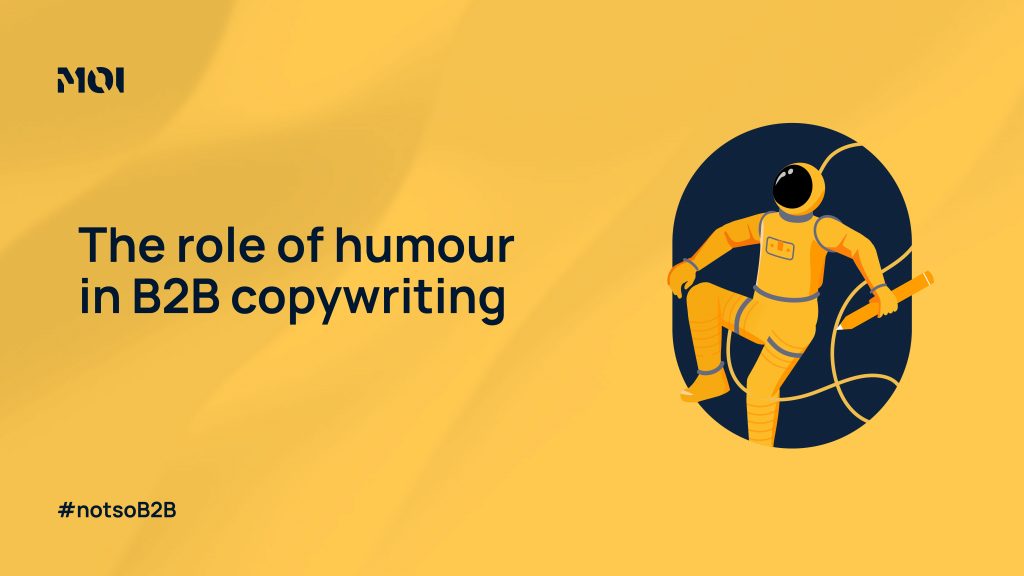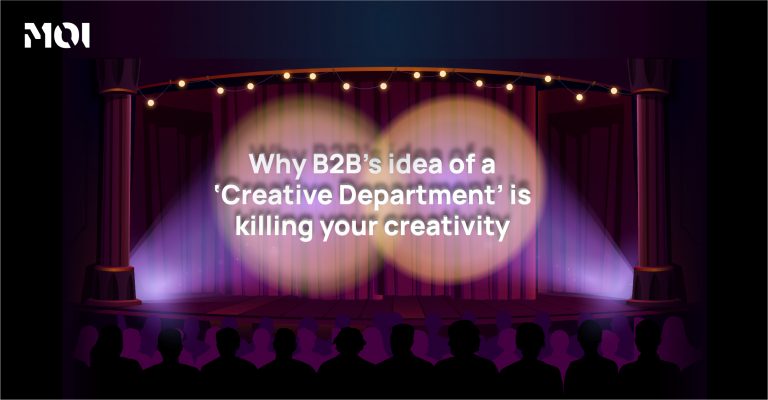
Right then, B2B marketers — here we go. You might be thinking, humour? In B2B copywriting? Surely you’re having a laugh? And, well, yes, we are! But also, we’re serious. Because while B2B marketing has historically been as exciting as watching paint dry, adding a splash of humour can take your copy from dull and forgettable to something that actually engages and entertains.
And let’s be clear — we’re not talking about knocking out stand-up comedy routines or turning your product descriptions into full-blown slapstick. No, what we’re after is balance. Just the right amount of wit, charm, and light-heartedness to get your point across without making people cringe or click away faster than you can say “corporate synergy.”
Humour actually belongs in B2B copy
Traditionally, B2B marketing is seen as the serious older sibling to its more exciting and fun-loving B2C counterpart. There’s this unspoken rule that B2B content must be stuffy, formal, and devoid of personality. Well, that rule is about as relevant today as a fax machine. Buyers today are humans (surprise!) and just like the rest of us, they appreciate a chuckle or two. In fact, using humour helps your brand stand out and creates a more human connection with your audience.
According to the Harvard Business Review, humour can help reduce resistance to messages, lower defences, and create a sense of camaraderie. It’s a shortcut to building rapport, which — let’s be honest — is often a tall order in the B2B world where buyers are typically sceptical and swamped with jargon.
Getting the balance right
Now, I know what you’re thinking. “Surely not everything in B2B is suitable for a gag?” And you’re right. There are definitely times when humour isn’t appropriate, such as when discussing serious business challenges or sensitive topics. But when used well, humour can make your message more memorable and even convey your expertise in a more relatable, human way.
Here’s where balance comes in. You’re not aiming for stand-up, you’re aiming for a subtle smile, perhaps even a chuckle. It’s about keeping things light while still maintaining the professionalism that B2B buyers expect. The humour should complement, not overpower, the message.
Do this, not that
Here’s a quick snapshot of how humour can elevate your B2B copy without turning it into a circus act:
Do this: “With our new CRM tool, even your Monday morning meetings might actually run on time. It’s like magic — only without the rabbits.”
Not this: “Our CRM tool will revolutionise your business processes and optimise your operational efficiency.”
See the difference? The first option gets to the point with a touch of humour while still conveying the product’s value. The second option, well, let’s just say it sounds like it was written by a robot.
When humour backfires
Just as quickly as humour can make a brand more approachable, it can also alienate your audience if it’s done wrong. Ever watch a comedian booed off stage? Yeah, it’s painful. And in B2B, poorly executed humour can be just as damaging. Go too far, and you risk coming across as unprofessional, or worse — offensive.
Take Slack’s advertising, for instance. They’ve found the perfect sweet spot of humour and productivity messaging. It’s light, it’s fun, but it’s never inappropriate. On the flip side, brands that overdo it often come off as trying too hard, and nothing kills a joke quicker than desperation.
If you’re a risk-averse brand, start small. Use a light joke in your email subject line, throw in a playful pun in your blog post, or experiment with witty social media captions. Keep testing the waters, and before long, you’ll find your brand’s humour sweet spot.
Do this, not that (Again)
Do this: “Finding the right software shouldn’t feel like solving a Rubik’s Cube while blindfolded. Let us simplify it for you.”
Not this: “Our software solution streamlines processes and eliminates inefficiencies for greater productivity.”
The first example makes the task of choosing software feel more manageable, while the second leaves you wondering whether you should have packed a dictionary.
Humour and brand personality
The key to successful B2B humour lies in its alignment with your brand’s voice. If your company already has a more playful tone, then going for cheeky one-liners and witty puns will feel natural. However, if your brand is traditionally buttoned-up, it might feel inauthentic to suddenly start throwing jokes around like confetti.
Case in point: look at Mailchimp. They use humour in a way that fits their quirky brand, helping them stand out in the crowded space of email marketing tools. But they still manage to keep the message clear and professional. It’s not all laughs — there’s still substance behind the punchlines.
Your humour should never overshadow your key message. It should support it. This means that a B2B SaaS company selling complex IT infrastructure might use humour to ease the reader into understanding the intricacies of their offering. After all, nothing breaks down the barriers of complicated tech talk like a well-placed quip or metaphor.
Do this, not that (One last time)
Do this: “Our cloud solution keeps your data secure — so you can stop dreaming about your servers catching fire. Sleep tight.”
Not this: “Our cloud solution optimises data security for peace of mind and operational efficiency.”
The difference? One sounds like a friend offering you some reassurance, the other sounds like you’re stuck on a call with the IT department.
It’s all about balance
Incorporating humour in B2B copywriting is about being human without sacrificing professionalism, about entertaining while delivering value. B2B buyers are, after all, people too. By injecting a bit of personality, wit, and charm, you can turn your content from forgettable to unforgettable. And in a world drowning in white papers and tedious reports, that can make all the difference.
So, next time you’re writing B2B copy, ask yourself this: Would I want to read this? If the answer is no, then it’s time to loosen that tie, take a deep breath, and crack a smile. Your audience will thank you for it.


